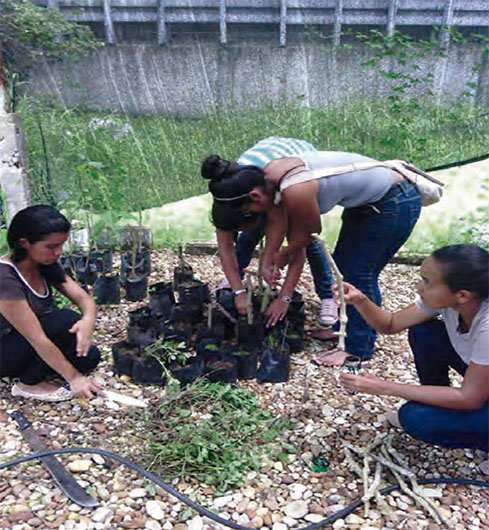Establecimiento de bancos de proteína vegetal como alternativas alimenticias en la producción de avicultura familiar
Abstract
Nowadays animal nutrition, especially poultry, takes importance due to the increase in production costs in the production of quality food for hens and chickens; However, it is necessary to be efficient in the feeding management of the birds, therefore, alternatives must be sought that provide the animal with the nutritional requirements, in order to optimize production and reproduction economically and in harmony with the environment.
Based on the above, the importance of plant species can be emphasized, forage plants of nutritional interest for animals, among which stand out: mulberry (Morus alba), nacedero (Trichanthera gigantea), forage peanut (Arachis pintoi) and moringa (Moringa oleifera), which have high nutrient content and are ideal for establishing protein banks.
Protein banks are extremely important in animal nutrition, since they manage to supply part of the demand for food that currently exists in the country, dehydrating the foliage to make flour or in a fresh state.
The producer can establish the protein bank with the plants mentioned above. The objective of this work is to show the experience in the field, with the communities, in order to motivate poultry producers to establish banks, so that they have natural food throughout the year and also, minimize the costs of poultry maintenance, improving the environment and its quality of life. The biomass production of a crop of forage plants, with high protein content, depends on the degree of commitment of the producer, who will offer their chickens and hens a quality feed at the time of processing, so that the birds can give a significant response in the production of meat or eggs.
References
Araujo, G.M.A., P. Araujo González y M.J.E. Ramones. 2014. La moringa y su uso en la alimentación de aves y cerdos. INIA Divulga 27 enero – abril. 21 p.
Holgado, F.D. 2011. El criollísimo maní forrajero. Producer XXI, Bs. As., 20(241):69-74 pp.
Ly, J., P. Samkol, and T.R. Preston. 2001. Nutritional evaluation of tropical leaves for pigs: Pepsin/pancreatin digestibility of thirteen plant species. Livestock Research for Rural Development, 13(5): (versión electrónica) http://www.cipav.org.co/lrrd/lrrd13/5/ ly135.htm.
Medina, A. 2013. Comercialización de Moringa Oleífera como complemento alimenticio para animales de engorde, reproductores y de leche: investigación de mercado y plan de marketing estratégico. Tesis de Grado. Universidad Casa Grande, Facultad de Administración y Marketing Estratégico. 51 p.
Murgueitio, E. 1991. Los árboles forrajeros como fuente de proteína. CIPAV. Serie de trabajos y conferencias. No. 2. 8 p. Navarro, F. y E.F. Rodríguez. 1990. Estudio de algunos aspectos bromatológicos del Mirasol (Tithonia diversifolia Hemsl y Gray) como posible alternativa de alimentación animal. Tesis Universidad Del Tolima. Ibagué, Tolima.
Odunsi, A.A., G.O. Farinu, and J.O. Akinola. 1996. Influence of dietary wild sunflower (Tithonia diversifolia leaf meal on layers performance and egg quality. Nigerian Journal of animal production 23: 1-2, 28-32 pp. Pezo, D. y M. Ibrahím. 1996. Sistemas silvopastoriles, proyecto agroforestal, Turrialba-Costa Rica. 40 p.
Pizarro, E. A. y A. Rincón. 1995. Experiencia Regional con Arachis forrajero en América del Sur. En: Biología y Agronomía de especies forrajeras de Arachis. Editor Peter C. Kerridge. CIAT. Cali, Colombia. 155-169 pp.
Shayo, C. 2001. Potential of mulberry as feed for ruminants in central Tanzania. In: Mulberry for animal production (Electronic Conference). Roma disponible en (http://www.fao.org/waicent /faoinfo/agricult/aga/ agap/frg/mulberry.html, 15 de enero de 2004).
Susana, I.W.R. y B. Tangendjaja. 1988. Leaf protein concentrates: Calopogonium caeruleum and Tithonia diversifolia. Proceedings Seminar Nasional Peternakan dan Forum Peternak “Unggas dan Aneka Ternak” ke dua. Bogor (Indonesia). BALITNAK. 1988. 190-202 pp.
Vargas, J. E. 1992. Evaluación de la aceptación del botón de oro en la dieta de las ovejas de pelo. Documento sin publicar.
Wagner, B. y R. Colon. 2007. Alturas y frecuencias de corte en la relación hojas/tallos y rendimiento de materia seca en Leucaena leucocephala (Lam.) de Wit. Congreso SODIAF 2007.


